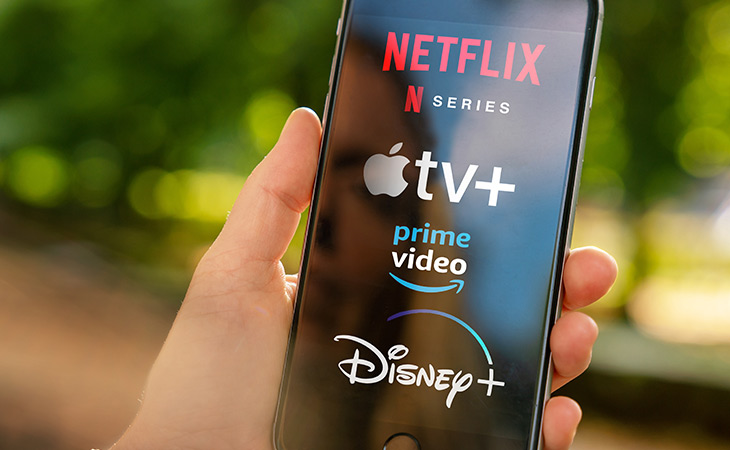The Next Big Streaming Trend Recommendations
10 Streaming Trends for 2021
January 6, 2021
This past year has been a wild ride, and most of us are eager to leave 2020 in the dust. With COVID-19 now a part of our everyday lives for the foreseeable future, the streaming media landscape finds itself at a significant turning point as we enter 2021.
In 2020, the streaming industry experienced growth like never before. The early days of lockdowns catapulted us five years forward in consumer and business digital adoption, with user-generated content, Zoom calls, and telemedicine at the forefront.
So, what's next for the streaming industry? Let's jump into our streaming predictions for 2021.
Top 10 Streaming Trends for 2021:
- Telehealth Continues Its Rapid Growth
- Artificial Intelligence (AI) and Machine Learning (ML) Push Forward
- Advancements in the Encoding Landscape
- User-Generated Content (UGC) Remains on Top
- Remote Personal Health and Online Fitness Growth
- The Streaming Wars Heat Up and OTT Adoption Continues to Rise
- The Shift to Live Commerce and Shoppable Media
- Smarter About Security
- The Future Is Bright for Cloud Gaming
- Emerging Tech and New Standards
Interactivity is the ultimate trend
Start a free trial to test our low-latency streaming capabilities.
Free Trial
1. Telehealth Continues Its Rapid Growth
The widespread adoption of telemedicine is, without a doubt, one of the pandemic's silver linings. COVID-19 has not only accelerated the healthcare industry's digital transformation; it's also helped to normalize it. Healthcare providers were forced to treat patients while practicing social distancing, and virtual doctor visits surged.
Forrester estimates that there were one billion U.S. telehealth visits by the end of 2020 alone. Remote patient monitoring and the internet of medical things (IoMT) continue to grow rapidly, as many healthcare companies have rushed to innovate during these trying times.

An estimated 20-30 billion IoMT devices are in use today.2
Healthcare professionals will continue to leverage streaming technology to modernize the way they treat and communicate with patients — while also enhancing internal training and knowledge sharing. A report from Deloitte predicts the percentage of virtual video visits to doctors "will rise to 5% globally in 2021, up from an estimated 1% in 2019." Deloitte added that consumers have grasped a better understanding of video-calling apps, especially seniors.
There is also ample opportunity to extend telemedicine beyond doctors to empower first responders and patients. Video-enabled telehealth capabilities will fill a crucial societal need and define the new normal. At the same time, remote surgery observation and training will allow experts in any location to push the industry forward faster.

2. Artificial Intelligence (AI) and Machine Learning (ML) Push Forward
As a frequent contender on our streaming trends list over the last few years, artificial intelligence will continue to gain prominence in 2021. Last year revealed both the best and worst of AI in the world of media, with Facebook's and Google's algorithms causing shockwaves for regulation. At the same time, AI counterintuitively fostered an appreciation for authentic forms of user-generated content (UGC) — exposing many to the joys of TikTok. As a result, media companies increasingly focus on UGC's power on now-dominant mobile platforms.

We predict the following developments for AI and ML:
- Previous experimental uses become core product features for live streams
- Automated metadata extraction
- Automated content-aware encoding
- Automated translation and captioning
- Object/motion detection and notification
- Context-aware advertising
3. Encoding Trends: Will H.264 Finally Die?
The industry has been talking about the Advanced Video Compression (H.264) codec dying for some time. And to be fair, it's made our past streaming predictions list a few times over the years. Is 2021 the year we finally see it perish? The short answer is no.

Here are the encoding trends we see leading the way this year:
- H.264 is here to stay. When you consider factors like processing power and cost, it's hard to beat H.264 encoding. There are simply too many devices still in the wild that only support H.264, such as IP cameras, set-top boxes, mobile devices, and low-power devices. Archiving is another reason it will remain relevant, as tons of recorded content exists today with nobody wanting to re-encode 20+ years of content for delivery. Alternatives are gaining traction now that users are seeing higher and higher bandwidth costs. Still, there is a lot of uncertainty in codec land, and it's hard to say if there will ever be a single dominant codec like H.264 has been.
- HEVC on the rise. High Efficiency Video Coding (HEVC/H.265) remains bullish in 2021. HEVC can deliver up to 50% better data compression than H.264 at the same video quality or, alternatively, substantially improved video quality at the same bitrate. This ability opens the door for the delivery of 4K and HDR video over existing delivery networks to the growing universe of viewing platforms.
- AV1 continues its rapid growth. Netflix has begun to use AV1 (replacing VP9) for certain mobile devices because of its low bandwidth requirements for a given video quality. As both encoding and decoding efficiency continue to improve, the adoption of AV1 will accelerate. The industry's preoccupation with comparing HEVC to VP9 will be replaced with a focus on how HEVC compares to AV1.
- VP9 adoption flattens. Google's VP9 is a powerful codec, but it has failed to gain widespread adoption because of its complex patent licensing process and the shifting of resources to AV1. YouTube and other large platforms will continue to use VP9 for a time – but is Apple adding VP9 support in OS11/iOS14 too little too late to slow the defections to AV1?
- VVC is on the horizon. VVC reached its final stages of standardization, and performance quality has yet to be seen. The VVC codec promises to improve visual quality and reduce bitrate expenditure by around 50% over HEVC.
- Content Adaptive Encoding (CAE) benefits. While traditional multi-pass encoding with a fixed bitrate ladder overspends bits for simpler contents, Content Adaptive Encoding solutions are emerging as a promising alternative. By allocating only the required bits for a given video, based on its complexity, CAE drives significant bitrate savings. Per title, per scene, per GOP encoding will become more widespread as distributors seek to maintain quality levels while decreasing bitrates.
- LCEVC may become more interesting. LCEVC is a codec-agnostic enhancement coding standard – that is, an add-on, not an alternative – which enhances any other video codec by simultaneously improving compression efficiency and reducing processing power consumption. It can reduce bitrate across multiple codecs, but it could also prolong the H.264 lifespan even longer.
4. User-Generated Content (UGC) Remains on Top

The pandemic has forced businesses in every industry to reframe the way they market themselves due to mandatory closures and a surge in online competition. Some may call 2020 the year of TikTok, but social media consumption across all platforms is up more than 42%, with consumers around the world spending more time on social media since the start of the pandemic. Brands have had to find alternative ways to connect with their audience — without studio setups and huge budgets bolstering their efforts.
Cue in User-Generated Content (UGC), which is built around a strong community. It's also relatable with consumers looking for uplifting content that acknowledges the difficult situation we're all in. The primary reason marketers value user-generated content is that it is the most authentic, trustworthy, and reliable form of content available across digital mediums.
"User-generated content marketing is any content shared by the users, which is repurposed by the brand for marketing. For brands, UGC is valuable as it is the feedback of the customers, and it holds their experience with the brand."
— Carol Sobers
The year ahead will be strong for UGC, with opportunities for higher quality content in platform and watch parties gaining traction. Also, to compete with the rise in popularity of TikTok, Instagram recently launched Reels, a new form of video content delivered in 15-30 seconds to create quick, attention-grabbing moments in a creative and entertaining way. Instagram's new UI update, which put IG Reels front and center, should hint to marketers that Instagram Reels will be here to stay in 2021.
5. Remote Personal Health and Online Fitness Growth
Online fitness saw tons of success in 2020 as gyms and fitness studios worldwide were forced to close their doors. These establishments had to quickly pivot to provide their communities with online workouts. And many clients are remaining loyal to their home studios as the pandemic continues. Although most gyms have reopened under strict COVID-19 guidelines, not everyone feels confident going back – which is why we will see a rise in online fitness trends in 2021.
Numerous fitness services now integrate live video streaming to recreate in-person experiences, effectively teleporting exercise regimens from fitness studios to our living rooms and basements. We saw the Peloton IPO explode, along with the likes of the Apple Fitness+ launch, Tonal, Mirror from Lululemon, and BeachBody all gaining large amounts of subscribers throughout last year – just to name a few. This fusion of live and interactive technology into the industry yields increased convenience, cost-savings, and more advanced capabilities.

This year the landscape will see advances in personalization via in-app artificial intelligence and machine learning increasing overall engagement through individual training offers and health stats. We will also see an increase in overall wellness and holistic inclusivity, virtual coaching, and wearable tech.
Wearable technology, fitness trackers, and fitness tech will continue to play a big role in shaping the fitness industry. With AI coaches, personal training assistants, and fitness innovations in augmented and virtual reality, the future of fitness tech looks bright. Fitness brands that don't integrate technology into their offerings will struggle to compete in a world of data and personalization.
6. The Streaming Wars Heat Up and OTT Adoption Continues to Rise
The streaming wars also made our streaming predictions list last year, as both fragmentation and consolidation ushered in a new era of direct-to-consumer streaming — and this year is no different as things continue to heat up. Both Apple TV+ and Disney+ launched at the end of 2019, which means they're still relatively new to the overall competition, but we have a variety of new players to consider in 2021.

These new players include HBO Max, Peacock, and the announcement that CBS All Access is getting a revamp as Paramount+. There's also the launch of Discovery+ and its roster of programming from the likes of Food Network, HGTV, and TLC — specifically90-Day Fiancécontent — on January 4th of this year. That's all in addition to Hulu, Amazon, and perhaps the only platform some of us watch anyway, Netflix.
The battle is on for every last subscriber. And we predict it will come to a head this year, with sign-ups on the decline as streaming services eventually run out of households to subscribe. There will be increasing competition and attempts to differentiate original content, including 4K, maybe even 8K quality towards the end of the year. But it remains to be seen how many providers the market will be able to support long-term.
Meanwhile, Warner Bros. announced that it will release its entire 2021 theatrical slate on HBO Max at the same time the films, which includeDune andMatrix 4, hit theaters. This announcement changes the film industry as we know it, and this will likely have a long-lasting impact on theaters.
It's abundantly clear that the shift towards OTT and the emergence of on-demand viewing has revolutionized how people consume content and maximize profitability. Creating an OTT platform is incredibly expensive, with AT&T pledging to invest $4 billion in HBO Max over the next three years. That includes the cost of programming for the service, as well as lost WarnerMedia earnings from steering movies and TV shows to HBO Max that otherwise would have been licensed to outside buyers. New and smaller providers will have to opt for managed platforms over bespoke solutions to save money, while more OTT and live services will be built on managed platforms rather than costly custom or tailored software.
Live commerce is a term used to describe the combination of streaming video and e-commerce, and it's been promising to revolutionize the retail industry and consumer shopping habits for years. While live commerce and shoppable media have been a popular monetization method for many brands over the last few years, it typically isn't utilized by brick-and-mortar stores. In 2021, we predict that will change.

According to a new report from the Interactive Advertising Bureau (IAB):
"The COVID-19 pandemic has accelerated a shift from the brick-and-mortar consumer economy to a 'storeless' environment by as much as 500%, permanently altering the brand value chain. Directly 'shoppable media,' such as live streams, social commerce, virtual consultations, and shoppable ad formats, will be the fastest-growing advertising categories in the near future as retailers and brands seek to reach consumers who are more likely to shop online. Live stream-generated sales are expected to double to $120 billion worldwide this year."
As we become accustomed to the new normal, businesses need to pivot to ensure sales keep coming in, while also prioritizing consumer health and safety. This shift toward contactless shopping will allow e-commerce stores to thrive even further this year. With social platforms such as Instagram and Facebook already beginning to integrate in-app purchasing, the steps traditionally required to convert a user to a customer will be reduced, and the gap between 'scrolling' and 'shopping' will be significantly blurred. Live commerce platforms will produce highly targeted personalized media. As overall attention spans continue to decrease, these businesses will need to focus on advanced consumer data and analytics to remain relevant.
Any traditional retail that can be turned into an online process will do so, and all in-person contact will be limited. This change will be adored by some and loathed by others as it significantly augments the way we're used to conducting business. This makes it even more important that the online version of your product or service is delivered at its highest quality and standard, especially when going live. This will also pave the way for non-disruptive advertising and drive purchasing during live commerce events.
8. Smarter About Security

The security industry is ablaze right now with technology providers continuing to innovate and develop new ways to help organizations defend against online security threats. Keeping customer data safe is a high priority across the entire digital landscape. This is no different for streaming services as the industry continues to grow and more people sign up for these services. Protecting our content becomes more important as use cases grow and privacy concerns continue to rise.
We predict the following advances in online security and encryption this year:
- Encryption at all levels, not just to protect monetization. Adoption of new encryption technology will emerge ahead of 2020's predicted curve. Newer data protection technologies, such as homomorphic encryption, will be adopted sooner than predicted as real-world use cases, like voting protection, demand solutions.
- Expansion of security adoption. Organizations will embrace new edge and remote technologies to further extend worker productivity and implement more security practices like data encryption to further safeguard the distributed workforce of the future.
- Cloud security will become the first-choice security strategy. One of the latest trends in cybersecurity will carry over into 2021. Organizations around the world will not only continue with a cloud-first strategy, but that will now include a cloud-first choice security strategy. As organizations gain more experience in remote working using cloud solutions, and with many planning to enable employees to work remotely permanently, cloud security will be key to enabling those employees to access business applications using privileged cloud access.
9. The Future Is Bright for Cloud Gaming
Last year, Google, Microsoft, Facebook, and Amazon each leaned hard into new cloud-streaming tech that shifts game processing and computing to cloud-based servers, allowing users to play graphics-intensive content on low-powered systems or play titles without dealing with lengthy downloads. The idea is that you can run games on cloud infrastructure and stream them to an end user's device that only decodes and plays the video. Prominent players already in this arena include Apple Arcade and Google Stadia.

Although 2020 didn't see the complete hype that was predicted early in the year, cloud gaming will be a hot topic this year as the gaming industry places all bets on subscription services. Year-over-year changes in gaming are rare because even if a historically unique platform launches or is unveiled, it takes time for a critical mass of developers to congregate and adopt something new — and even longer for users to adopt it.
We'll continue to see a more coordinated move toward driving subscription growth and moving farther away from an industry defined for decades by one-time purchases structured around single-player storylines, instead toward one dramatically shaped by internet networking and instantaneous payments infrastructure software. This year will also focus on continued developer movement toward online cross-play between gaming platforms, a trend long resisted by legacy platform owner's intent on maintaining siloed network effects that pushed gamers toward buying the same consoles that their friends owned.
10. Emerging Tech and New Standards

Every year we come across new standards and emerging technologies that have the strong possibility of enabling lower latency, higher quality, new application types, and greater streaming efficiency across the industry. Our final streaming trend on our 2021 list is where we see the greatest opportunities for streaming advancement happening this year:
- QUIC and HTTP/3: HTTP/3 will continue to make the web better for everyone. Continued development will bring HTTP/3 and QUIC from budding standards to widely adopted technologies for improving the web.
- WebCodecs and WebTransport: Progress towards standardization and implementation of the WebTransport API and WebCodecs API.
- LL-HLS and LL-DASH will be Deployed at Scale: Large-scale deployments of Low-Latency HLS and Low-Latency DASH will gain traction in 2021. Integration from vendors across the live video delivery ecosystem will come to the forefront as an end-to-end solution optimized for the latest version of the specification.
- 5G = More and Higher Quality Experiences on Mobile: 5G will actually be noticeably different this year, with 5G in more locations than ever before. More bandwidth to devices could mean more real-time interactivity.
Peace Out 2020. It's Been Real.
There you have it — our 10 predictions for the streaming industry in 2021. Sure, there are also plenty of harder-to-predict developments that will occur in 2021… But after 2020, an alien invasion from outer space wouldn't seem so weird.
About Barry Owen

Barry Owen is Wowza's resident video streaming expert and vice president of solutions engineering. In this role, he leads a team dedicated to helping customers succeed. From architecting custom applications to solving complex problems, Barry leverages more than 25 years… View more
The Next Big Streaming Trend Recommendations
Source: https://www.wowza.com/blog/streaming-trends
Posted by: cammackreamost.blogspot.com

0 Response to "The Next Big Streaming Trend Recommendations"
Post a Comment